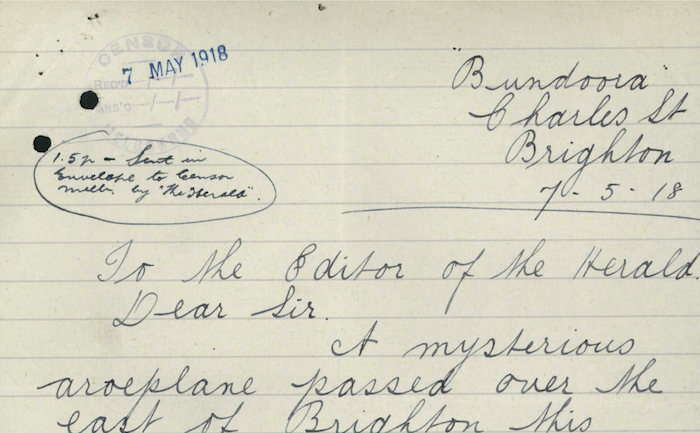
NAA: MP1049/1, 1918/066, page 997 is a copy of a report from 2nd Lieutenant C. Kingsford Smith RFC on ‘investigations made at Gosford and Terrigal, re aircraft seen there at night’. Kingsford Smith has been sent up from Sydney on the basis of his experience as a pilot on the Western Front. His account can largely be divided in two parts. First, there is his account of what other people said they’d seen, including ‘Miss Moir, who subsequently impressed me as being very reliable’ and
who stated that she distinctly heard the noise of an engine, and on a previous occasion saw a light in the air travelling fairly rapidly and flashing (probably signalling in Morse Code) and an answering signal from a hill near the coast, and a little north of Terrigal. The position of Miss Moir’s house is extremely favorable as a lookout Station.
as well as Mr Wood, ‘who is in charge of the Boy’s Reformatory‘ and who
asserts that about 4 weeks ago, the whole of the staff and inmates were awakened by the noise of an engine passing overhead. The [Gosford Police] Sergeant informed me that Mr. Wood has an excellent reputation and is absolutely dependable.
Then there are Kingsford Smith’s own observations, especially the one made from Terrigal Beach ‘opposite Mr. Lewis’s house’:
At 2.30 a.m. [8 May 1918] I saw what was extremely like a white Verey [sic] light fired from a point about 3000 feet up and a mile north of us. At the same time I saw a small black object rapidly going inland. I could hear no sound as the Surf there drowns any other local noises. I would not attach any grave importance to this episode, as I know how easily one can be deceived at night by falling meteorites, and passing birds, but I certainly think it was a machine. We were not in a position to see any answering ground light.
Kingsford Smith’s conclusion is that
There is most certainly a foundation for all these reports, and I think that someone should be stationed in that locality (for a couple of weeks or more) who has some experience in connection with aircraft and observation.
In my article I cite Kingsford Smith’s report primarily, I admit, because of his later fame as a pioneer aviator, but also for his open-minded conclusion as a counterpoint to the scepticism of Sickerdick and Edwards, the latter of whom was, like Kingsford Smith, an RFC officer (though whether a pilot or not I’m not sure). But as I’ve gone into Kingsford Smith’s experiences as well as the previous Terrigal sightings — including the suspicious ubiquity of Miss Moir and Gunner McNaughton — in much more detail previously, I’ll say no more here.
![]() This work is licensed under a Creative Commons Attribution-NonCommercial-NoDerivatives 4.0 International License.
Permissions beyond the scope of this license may be available at http://airminded.org/copyright/.
This work is licensed under a Creative Commons Attribution-NonCommercial-NoDerivatives 4.0 International License.
Permissions beyond the scope of this license may be available at http://airminded.org/copyright/.





